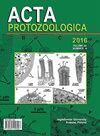韩国土壤纤毛虫一新种,Birojimia soyaensis 11 . spec.(纤毛虫目:尾虫纲)
IF 1.5
4区 生物学
Q4 MICROBIOLOGY
引用次数: 2
摘要
在韩国仁川黄豆岛发现了一种新的土壤尿状纲纤毛虫——Birojimia soyaensis nov.。该物种是根据活体和染色标本观察和18S核糖体RNA基因序列分析来描述的。黄斑飞虱(Birojimia soyaensis十一月种)具有以下特征:身体细长,伸长,有点扭曲;体内体尺寸170-200 μm × 40-50 μm;左侧细胞边缘中部有收缩的液泡;存在皮质颗粒;37-48口膜;有3个前缘卷和2个前缘顶卷;III/2和颊卷云存在;仅中部腹侧对;前横腹和横卷存在;左边缘行1行,右边缘行4行,其中复合行3行;5个长背体,在前面复合排中有3个额外的短背体;8-11尾卷;53 ~ 69大核结节;还有2到3个微核。大豆比罗jimia soyaensis 11 .的区别在于其皮质颗粒大小(直径为0.4 ~ 1.2 μm vs. 2 ~ 3 μm × 1 ~ 2 μm)、皮质颗粒形状(分别为球形、椭球状和透镜状);尾端刚毛的数目(8 - 11对2-7)和背刚毛的数目(8对6-7)。系统发育分析表明,该新种与半环草属亲缘关系最为密切。本文章由计算机程序翻译,如有差异,请以英文原文为准。
A New Soil Ciliate, Birojimia soyaensis nov. spec. (Ciliophora: Urostylida)from South Korea
A new soil urostylid ciliate, Birojimia soyaensis nov. spec. was discovered from Soya Island, Incheon, South Korea. The species is described based on live and stained specimen observations, and 18S ribosomal RNA gene sequence analysis. Birojimia soyaensis nov. spec. is characterized by the following features: body slender, elongate, and somewhat twisted; body size in vivo 170–200 μm × 40–50 μm; contractile vacuole located at middle of left cell margin; cortical granules present; 37–48 adoral membranelles; 3 frontal and 2 frontoterminal cirri present; III/2 and buccal cirrus present; midventral pairs only; pretransverse ventral and transverse cirri present; 1 left and 4 right marginal rows, including 3 compound rows; 5 long dorsal kineties with 3 additional shortened kineties in anteriorly compound rows; 8–11 caudal cirri; 53–69 macronuclear nodules; and 2 or 3 micronuclei. Birojimia soyaensis nov. spec. is distinguished from B. terricola by cortical granule size (0.4–1.2 μm in diameter vs. 2–3 μm × 1–2 μm), cortical granule shape (mostly spherical vs. broadly ellipsoid to lenticular, respectively); number of caudal cirri (8–11 vs. 2–7), and number of dorsal bristle rows (8 vs. 6–7). Phylogenetic analysis suggests this new species is most closely related to the genus Hemicycliostyla.
求助全文
通过发布文献求助,成功后即可免费获取论文全文。
去求助
来源期刊

Acta Protozoologica
生物-微生物学
CiteScore
2.00
自引率
0.00%
发文量
8
审稿时长
>12 weeks
期刊介绍:
Acta Protozoologica - International Journal on Protistology - is a quarterly journal that publishes current and comprehensive, experimental, and theoretical contributions across the breadth of protistology, and cell biology of Eukaryote microorganisms including: behaviour, biochemistry and molecular biology, development, ecology, genetics, parasitology, physiology, photobiology, systematics and phylogeny, and ultrastructure. It publishes original research reports, critical reviews of current research written by invited experts in the field, short communications, book reviews, and letters to the Editor.
 求助内容:
求助内容: 应助结果提醒方式:
应助结果提醒方式:


